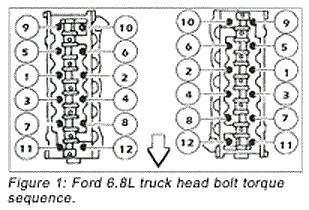Engine Builders: The AERA Technical Committee offers the following information regarding cylinder head bolt replacement for 1997-2003 Ford 6.8L VIN S engines. This engine requires new replacement cylinder head bolts any time the head is installed.
Follow the procedure listed below after all components have been thoroughly cleaned and prepped. Ensure that all surfaces of the cylinder block, cylinder head, and gasket are free of any solid or liquid contamination and have been prepared for assembly using Motorcraft Metal Surface Cleaner, F4AZ-19A536-RA (or equivalent) solvent. Also ensure that all dirt is removed from the area surrounding the head and the block. Verify the cylinder head flatness and surface finishes are appropriate for the MLS (multi-layered steel) gasket seal.

For vans, the four center bolts must be installed in the cylinder head before placing the cylinder head on the block when the engine is in the vehicle. To install the cylinder head without damaging the gasket or the gasket-mating surfaces, lift bolts 1-4 slightly above the cylinder head gasket-mating surface and hold in place by using a large rubber band.
The new head bolt shanks and threads should be thoroughly cleaned, dried, and lightly lubricated. Oil the bolts and let oil drip for a minimum of 5 minutes as use of too much oil may cause hydraulic lockup in the bolt holes. Install the head gasket, the cylinder head and all of the NEW fasteners finger tight, and then tighten the bolts in the following three stages and reference the illustration shown in Figure 1.
- Tighten all bolts in sequence to 30 ft.lbs. (40 Nm).
- Rotate all bolts in sequence an additional 85













